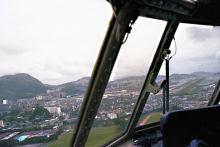7 Dec 1941, Chronology of Events Related to Stanley Civilian Internment Camp
Primary tabs
Methodist minister Joseph Sandbach is conducting a service in the middle of the defence line in the New Territories. He notices the continual activity of runners carrying messages and realises something's about to happen.
The new Colonial Secretary, Franklin Gimson, arrives. He finds a Colony preparing to be attacked.
A State of Emergency is announced. Troops are ordered into position, and the Volunteers are called up.
An afternoon radio broadcast alerts some civilians to the call up of the troops and of the workers in Essential Services. But some people continue 'the usual social round, unaware or uninterested in the fact that the soldiers were proceeding to their battle stations'.
American oilman Norman Briggs doesn't notice anything unusual in the morning - 'it was just an ordinary Sunday'. But in the afternoon he takes his dog for a walk around Lugard Road 'which encircles the Peak and (gives) an excellent view of the harbor'. He notices that there are fewer ships there than usual, and he remembers a conversation yesterday about ships going to Manila and Singapore; but as Hong Kong is a busy port he still isn't overly concerned.
Hilda Selwyn-Clarke, wife of the Director of Medical Services, and her friend Margaret Watson are planning to have dinner at Shatin with Dr. Isaac Newton, chief surgeon at the Kowloon Hospital. Watson rings up Newton and says that Hilda had decided she must leave Kowloon for Hong Kong Island. Watson accompanies her. Newton is aware of the Volunteer call up but doesn't feel that the Japanese will act before the result of the Moscow fighting is known.
Hong Kong and Shanghai Banking Corporation employee M. G. 'Mike' Carruthers tells the Chief Manager Sir Vandeleur Grayburn that he, as a Volunteer, has been called up. Sir Vandeleur looks at him in horror and tells him he can't go - 'this is going to blow over'.
Director of Medical Services Selwyn Selwyn-Clarke has told Hong Kong University biologist G. A. C. Herklots to devise a 'siege biscuit' that will provide the population with basic nutrition during a siege of three months or so. Herklots, as part of a broader programme of nutritional preparation, set about his work:
With the enthusiastic co-operation of a master baker ((Thomas Edgar)) and after about thirty trials, it was found possible to make a hard siege-ration biscuit from this meal and whole wheat flour.
The biscuit is thoroughly tested and proves palatable to all sections of the population. Today an improved version is devised, presumably at Lane, Crawford's Bakery in Stubbs Rd:
On the day before the Japanese attacked, a satisfactory biscuit was made which contained added calcium carbonate and shark liver oil.
Production will stop on December 15 when the Bakery has more urgent tasks.
New Zealander James L. Anderson is in charge of the Kowloon radio station. He's living with fellow Hong Kong Telephone Company employee Les Fisher. During the course of the day they realise that war is about to start, so in the evening they go to the Majestic to cheer themselves up:
The picture we saw was 'The Long Journey Home', very good but most depressing.
In the evening New Zealand writer James Bertram returns from Lantau Island where he's been visiting a well known Buddhist businessman, 'Hermit Yen'. With him are Norman France, a lecturer at Hong Kong University, and his neighbour Stephen Balfour:
{Balfour was} one of the few good Chinese scholars the colonial service had produced. France and Balfour between them summed up what was for Hong Kong a rare combination of culture and intellectual interest; both of them were to be casualties of the war.
Missionaries Mr. and Mrs. H. F. Collier have come to Hong Kong to get dental treatment and buy supplies for their station at Yeung Kong. It's getting close to the time of return, and they're spending the day with Chinese Christian friends:
We were a happy party together, and the day passed quickily without our having any thought that it was the last day of quietness and comfort that we should see for many years.
Sources:
Sandbach: http://www.iwm.org.uk/collections/item/object/80004743
Gimson: Tony Banham, Not The Slightest Chance, 2003, 15
Emergency, Social Round: Tony Banham, Not The Slightest Chance, 2003, 17; John Luff, The Hidden Years, 1967, 14
Afternoon broadcast: Bernard Tohill, 'Some Notes From A Diary Of The Years 1941-1942'
Briggs: Norman Briggs, Taken In Hong Kong, 2006, Kindle Edition, Location 491
Selwyn-Clarke, Watson, Newton: Alan Birch and Martin Cole, Captive Christmas, 1979, 5
Grayburn: Frank H. H. King, History of the Hong Kong and Shanghai Banking Corporation, Volume 111, 1988, 569
Herklots: http://brianedgar.wordpress.com/2012/03/12/thomass-work-1/
Fisher: Les Fisher, I Will Remember, 1996, 11
Bertram: James Bertram, Beneath The Shadow, 1947, 69-70
Colliers: F. D. and H. F. Collier, Covered Up In Kowloon, 1947, 16
Notes:
1) Other sources put Gimson's arrival on December 8th.
2) M. G. Carruthers was seconded to the Middlesex Regiment to provide local knowledge and ended up being told to carry the white flag around the line after the surrender. He was awarded the Military Cross for 'this and related activities'.
Frank King, History of the HKSBC, Volume 111, 1988, 571
3) See for more on:
death of Balfour: http://gwulo.com/node/11602
death of France: http://gwulo.com/node/13841
the siege biscuits: http://brianedgar.wordpress.com/2012/04/08/thomass-work-5-the-siege-bisc...

